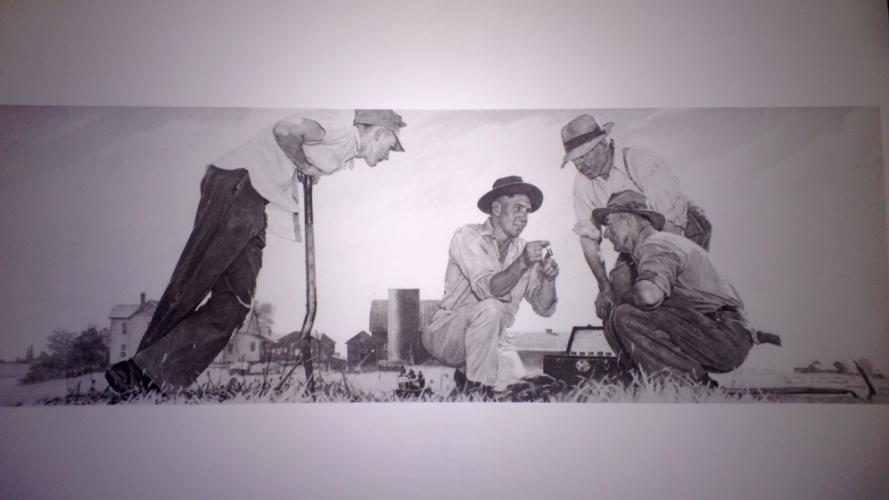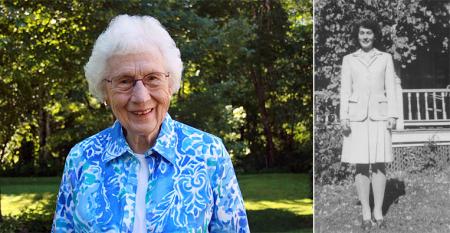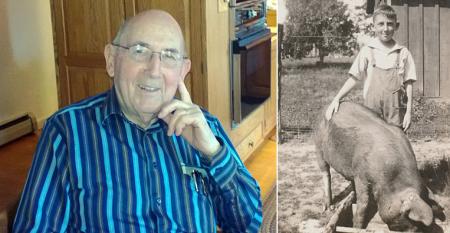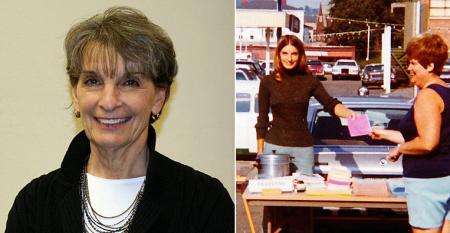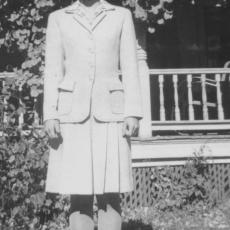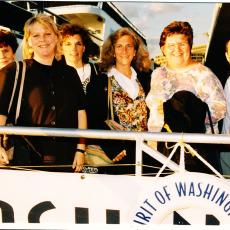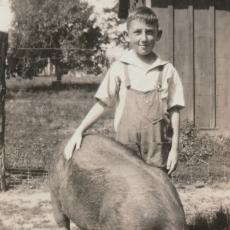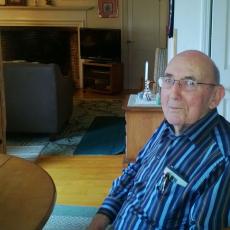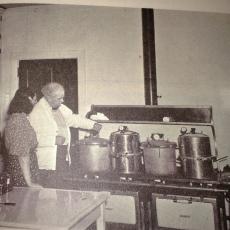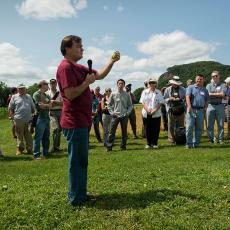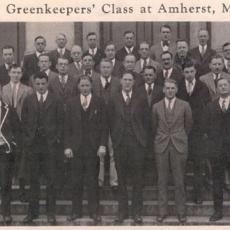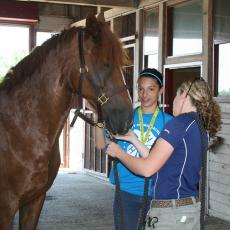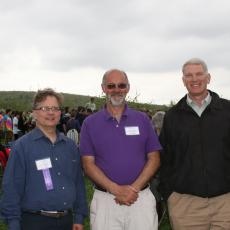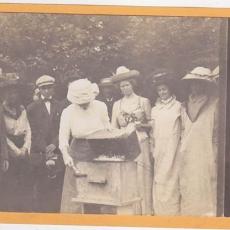In Our Spotlight
UMass Extension: At Your Service for 100 Years
The Dean of the College of Natural Sciences, most recent in a series of successor colleges to UMass Amherst’s College of Agriculture, likes to tell the story of how Norman Rockwell strode up the steps of Stockbridge Hall some time in the middle of the last century, his sketch of county extension agents rolled up under his arm. The artist thought that someone at the college might be interested in owning his portrayal of their work in the field. This beautifully-illustrated and signed image graced the pages of the Saturday Evening Post in 1948, and is now a University of Massachusetts treasure. Entitled, "Norman Rockwell Visits a County Agent," this rendering shows the scientific work performed on countless farms throughout our nation in the early days of Cooperative Extension (in the Commonwealth, we call it UMass Extension). At this moment, as we pause to honor the foundational work of thousands of county agents and campus-based specialists and faculty across the state and country since 1914, we are grateful to have this strong image to honor their work.
We spoke with three individuals who devoted their professional careers to helping others through Cooperative Extension. Their reflections represent sentiments from many others who served at a time when Extension's work was more hands-on in nature. With the advent of high technology and instant information-sharing through the internet, the nature of this work has changed. There are no county agents in Massachusetts any more (with the exception of Cape Cod Extension)… Today, UMass Extension continues to serve communities through education and outreach. Extension faculty continue to conduct research, visit farms, dispense advice to farmers and others, offer educational workshops, hold seminars and more. The UMass Extension websites are treasure-troves of regularly-updated research-based information and learning tools on topics from farming to nutrition, food safety, the environment and youth development.
Meet Peg Randall, Merle Howes and Gretchen May, representing the work of many others.
Peg Randall: “Extension was what I did most of my life.”
Peg Randall
After a brief conversation with the lively Peg Randall, one wishes she would have been your colleague. Her enthusiasm for the work of Extension comes through with sheer joy and keen dedication. Throughout her working life, she held many titles within the organization. Among them: Associate 4-H Agent, County Home Agent, State 4-H Leader in Home Economics, State Program Director in Expanded Food and Nutrition Education Program and Staff Development. Her area of interest and expertise in textiles can be seen with hand-crafted items throughout her home, including a lovely hand-braided rug.
During her years with Cooperative Extension, as times and societal interests evolved, so did the nature of her work in response to the change. Peg, a 4-H member since childhood, began her professional career in 1948 as Associate 4-H Agent in Dutchess County, NY. Following graduate work at the University of Wisconsin, she remained in Wisconsin three years as County Home Agent in Wausheka County. Her next professional position brought her to New England in 1956 where she became State 4-H leader in Home Economics, based in Munson Hall at the University of Massachusetts. She left full time employment in 1962 when she married, but kept connections with Extension through volunteer 4-H leadership in her local community.
Substitute teaching and a few years as Assistant Professor of Home Economics in Textiles and Clothing at UMass paved the way for an early return to professional employment. In 1972, when her former job in the State 4-H office became available, she returned to that position, again heading up 4-H home economics programs in Massachusetts. At that time, a new federally-funded program had been incorporated into that assignment: nutrition education for low-income children, especially in inner cities. In 1977, Peg accepted a position as State Director of the Expanded Food and Nutrition Education Program, which annually reached 2,000-3,000 families in the Commonwealth. She relays that no matter what ages her team worked with, the knowledge, skills and attitudes gained all worked together to contribute to improving the quality of everyday living. Young people and adults learned how to manage their resources more effectively and developed leadership skills and abilities to become more productive citizens.
When asked which accomplishments she was most proud of, she replied, “All of them for different reasons, but all centered on Extension’s major purpose: Helping people help themselves. Extension has made wonderful contributions to the lives of people throughout its 100-year history.”
She retired, formally, in 1990 but true to her commitment to this work, she then continued to work for three more years in New England Institute for Extension Education to educate staff about Extension policies and procedures and was involved with development and implementation of a variety or personnel policies in UMass Extension.
Tomorrow and Beyond
Peg is both reflective and forward-looking. She states that, “Subjects within Home Economics, including nutrition, food and health, consumer affairs, and family and child development are relevant any place, any time.” As wonderful as Cooperative Extension was in relating to people in its heyday to make the information real and understandable, maybe we can’t afford some of those earlier methods today. We have to reach people with other approaches, including those who learn differently.” These days are there are lots of ways to get information. She said, “People can pick up their i-phones and i-pads and find information instantly.”
Peg’s observations about the current status of areas in which she worked include: Canning and preserving: these food practices seem to be receiving increased interest due, in part, to growing concerns in related food safety and health issues; Sewing: there used to be a fabric store on every corner. Fabrics were plentiful and economical. Today with much of the labor supply located off-shore and much less expensively (than in the U.S.), ready-to-wear clothing is more affordable. Our society’s ‘disposable living’ products and planned obsolescence practices combine to make constant fashion changes essential market demands. It is no longer economical to sew one’s own clothes, but rather it has become an interesting hobby. Also, fewer and fewer people have sewing skills today as they have not been passed on to new generations. Quilting is one sewing activity that seems to be gaining popularity as a more favored textile craft.
However, she contends that we still need scientific study and research in the broad fields of agriculture, home economics, nutrition and food safety so that we continue to search for and develop new and improved products and methods.
Peg reflects upon her work over the years. She said, “One of the most important things that flowered beautifully with Extension was teaching people to help themselves: simple or complicated, skills or information, it did not matter. It was satisfying to make a difference in someone’s life. Our programs were designed to meet the needs of people. We spent time with them in meaningful subject areas and hopefully, those teachings changed lives. A delivery system that was made of humans was pretty amazing. We worked closely with county agents who had wonderful ideas that benefited from our “packaging” them for practical use. That was one of our most important jobs.”
When asked which job she most enjoyed, her reply was classic Peg, “I loved every job I ever had! In a nutshell, I was always trying to build connections between our audience and the vast knowledge base of Extension that would solve a problem, would address an issue or be a meaningful experience.”
Peg Randall, a beloved educator and Extension leader, supportive and affirming others in her many professional roles, has made a world of difference for so many, which had always been her goal. It is nice when a plan comes together.
Introducing Merle Howes, A Champion for Youth and 4-H for Over Seven Decades
Merle Howes: 4-H advocate, retired 4-H Director, historian, former selectman, retired farmer.
One would need to look far and wide to find a better historian to discuss the work of Cooperative Extension (now called UMass Extension in Massachusetts), than Merle Howes. His passion for the work and his clarity about its legacy and future are crystal clear. We caught up with Merle at his home in Amherst, just on the eastern edge of the University campus where he worked for many years.
Merle Howes
Maryland Farming Roots
A subtle Southern accent remains as Howes relays his childhood memories… explaining how growing up on a 237-acre farm in Maryland led him directly to a meaningful career. His family was involved in every aspect of a large livestock and crop farm. He recalls the frequent visits made to the farm by Extension agents to discuss soil pH, livestock care and to share vital information that rural farmers needed to understand. His deep-seated love of farming can easily be traced back to those hands-in-the-soil days. The Howes family helped to start the Montgomery County Farm Women's Market [http://www.farmwomensmarket.com/] a successful endeavor that helped area farms thrive during the Great Depression. They sold chickens, preserves, produce and cakes as well as aprons made from old feed sacks (such products are making a comeback in 2014, now we call it ‘recycling’). Over the years, the market has grown to become a thriving cooperative.
Learning from college professors about events in Europe while attending 4-H “Club Weeks,” Howes was impressed with the academic presentations he heard and became inspired to attend college. Growing up with rich ideas gained from 4-H experiences had become part of him… so much so that 4-H became his life’s work.
But first, WWII intervened to find Howes serving our country in the Army in chemical warfare service while stationed in England. His military service then allowed him to take advantage of the GI Bill at Kansas State, an enticing offer he could not refuse. After college, he became a county Extension agent and served as an Assistant 4-H state leader in Maryland.
He and his wife, Billie, moved to Amherst in 1956 where he was offered the position of state 4-H leader. However, his thirst for knowledge led him to work toward and gain his doctoral degree at the University of Wisconsin, Madison. With his diploma in hand, his family decided that Amherst felt like home and settled right back into the community. Not only was Howes deeply committed to work in Extension and 4-H, but at that time he also undertook major renovations to a historic home – the same beautiful home where he spoke to us recently -- and served as selectman in Amherst from 1965 to 1975.
A 4-H Legacy
Howes has worked much of his professional life to expand and grow the Massachusetts 4-H Foundation, founded in 1955. He diligently sought and found private support to ensure its long-term stability. The mission of the 4-H Foundation is to ensure that 4-H remains a vital center of excellence for youth development. Under Howes visionary leadership, one can say: Mission Accomplished!
Extension past and future
Howes and his wife are avid amateur historians and relay the following background to the beginnings of the Cooperative Extension Service.
From 1906 to 1924, Kenyon Butterfield was President of Massachusetts Agricultural College. He was deeply engaged in agricultural matters at the national level and provided leadership to Extension Service nationwide.
He was involved with the founding of the American Country Life Association and was then appointed to that influential association by President Theodore Roosevelt. Out of this effort, the Cooperative Extension Program was formed. It was the strong position of Butterfield that the foundation should originate in community and that it be connected to land-grant colleges rather than a straight line to the federal government. His belief was that this would be the most effective way to serve at a local level. Howes is on a quest to locate a plaque that once adorned South or North College at Mass Aggie stating this was one of the first buildings in the U.S. to house Extension Service offices and where Kenyon Butterfield gave leadership to the Extension Service nationwide.
Extension has a tough road, according to Howes, former Assistant Director of Extension for 4-H at UMass Amherst. He says that Extension must go right to the client since clients have many options today for seeking answer with the internet chief among them. Howes believes that people are not using the rich resources of Extension as much as they once had. He thinks there must be a willingness and ability to go to the problem, to be prepared for it, not wait for it to come to you, an attribute for which Extension has become known. Current Extension programs such as twilight meetings and workshops held on farms go some way to support his assessment of how the future should unfold to keep Extension’s work relevant.
4-H Outlook
“Young people still benefit tremendously from home-based projects. That’s the distinction and the difference that sets 4-H programs apart from others. There are plenty of opportunities and it is essential for thinking parents to offer this as an option for their children,” observed Howes. Indeed, a 2012 Tufts University study (http://4-h.org/about/research/) found that 4-H’ers report better grades and are nearly two times more likely to plan to go to college. They are 3.4 times more likely to actively contribute to their communities when compare to youth who do not participate in 4-H.
Going Forward
If a personality fits the job, then one can certainly say the Merle Howes has been well-matched to his Extension challenges. He said he always liked his colleagues in Extension and anyone who knew him certainly has a positive reaction to him. With his toes on the brink of his ninth decade, he said with a twinkle in his eye: “Reflect and project. It is how we got this far and what will carry both Extension and 4-H forward.” With his strong legacy and love of 4-H he has set the feet of many a youth on a strong and steady path for a long time to come.
Portrait of an Extension Champion: Gretchen May
Franklin County, Circa 1977
Gretchen May
If you lived in Franklin County Massachusetts up on the Vermont border in and around the Connecticut River Valley in the 1970’s and 80’s, you just might remember Gretchen May. May was so synonymous with the Cooperative Extension Service in Franklin County during her days in the 1970’s and 80’s that people are still talking about her work in these communities several decades later. May was hired as a County Extension Agent “pre-internet” in 1977 responding to the needs of 23,000 families in Franklin County. Her role was as a Home Economist who delivered research-based information through hands-on workshops, radio shows, newspaper articles, home visits and newsletters that reached all 26 towns.
Local radio DJ Jay Fidanza conducted lively weekly interviews with May broadcast over WHAI airwaves from Greenfield. (Thirty-seven years later, Fidanza continues to provide the hometown element to WHAI.) Recently, he said, “Not only was Gretchen an “easy” interview but she also came across the air as friendly as well as knowledgeable. The information she shared with our listeners was always pertinent and easily applicable and I am sure some of it is still being put to use by those who heard her.” May often shared information about seasonal topics (food preservation in the summer along with planting tips, how to cook a turkey in November, key to choosing a perfect Christmas tree in December, etc.). For the record, Gretchen still listens to Fidanza every day.
UMass Educated
May developed an interest in textiles and sewing when she was a student at UMass Amherst with a job working in the fabric department of a local department store. She received her bachelor’s and master’s degrees from UMass and worked with textiles in several positions before starting her career with what was then called the Massachusetts Cooperative Extension Service.
Topics in An Ever-Changing Home Environment
May’s first job with Extension was as an Extension Home Economist, based in the Courthouse in Greenfield. She and her colleagues taught people in Franklin County how to use newly-available microwave ovens, answered questions about stain removal and food preservation, and wrote booklets about making homemade baby food. As technology changed, so did the nature of her work. When she developed stain removal recipes, for example, there were very few commercially-available products on the market. That has all changed. May’s areas of expertise were not only textiles and sewing but also child development. In the 1980s, as part of a statewide Extension effort, May helped people develop safe and legal home-based businesses, including catering, family daycare, sewing, housecleaning, and running bed and breakfasts. Issues around child development, family day-care providers and “latch key kids” came to the forefront. May offered a variety of workshops for day care providers to address licensing and insurance matters.
In the late 1980s and 1990s, May and her colleagues worked with the state Department of Transitional Assistance to offer workshops to adults transitioning off welfare, with topics such as: budgeting, managing stress, resume-writing and parenting while working. When Extension’s 4-H and Family Life programs were combined, May’s job became Extension Educator in 4-H Youth Development. As part of her Extension job since 2005, May has served as the Mass. 4-H Military Liaison working across the Commonwealth to coordinate, network, and facilitate programs and resources in support of military children, youth, and families, often in partnership with other groups.
May says, “Everything about the way we provide services to communities changed with budget cuts, when county offices were dismantled and when the internet became used more widely. I support the internet for access to information, but people need to know what they are looking at and whether or not it is reliable information.”
Through the years, May has been called upon to constantly update her skills and knowledge. Recently, she commented, “Then and now, I draw upon my network of resources across the Commonwealth and the U.S. and use many ways to get the message across. It is all part of Extension’s mission, working with families to help them improve their lives.”
G. May profile written with assistance from Mary McClintock , M.Ed. ’89